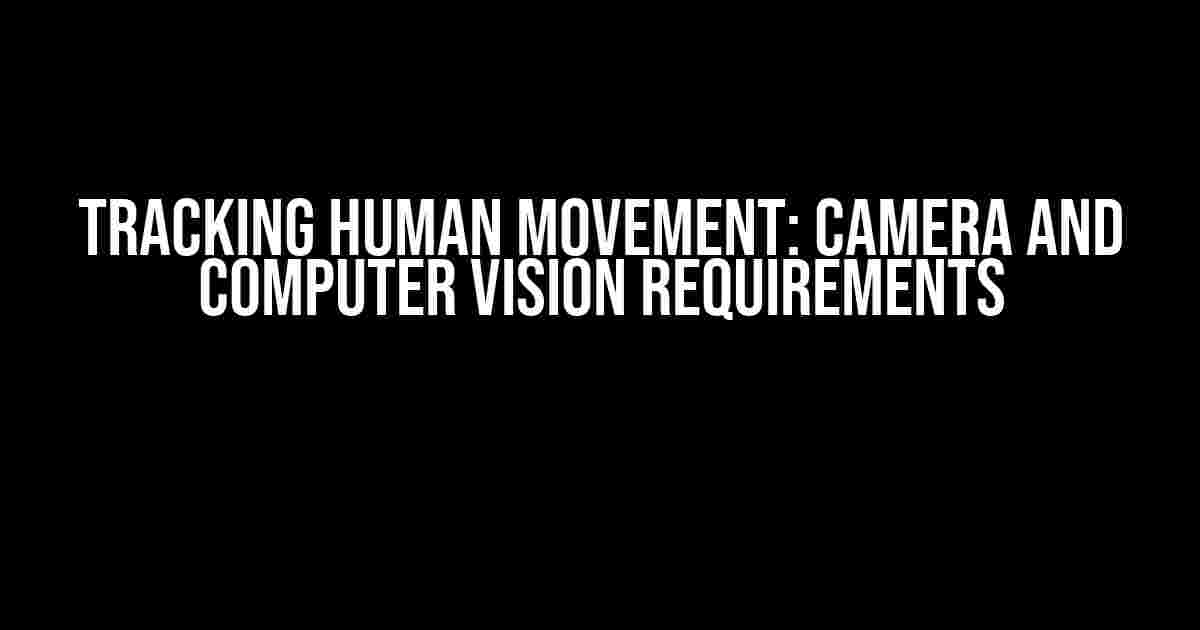To track a human looking for a specific movement, a combination of camera and computer vision hardware and software are necessary. The type of hardware and software required depends on the level of accuracy, range, and environment of the tracking system.
Camera Requirements
A high-quality camera with the following specifications is necessary:
- High-resolution sensor (minimum 720p, preferably 1080p or higher)
- Wide-angle lens (90° or wider) to capture the human figure
- High frame rate (60fps or higher) to track rapid movements
- Low-light sensitivity to operate in varying environments
- IP67 or higher rating for dust and water resistance (if outdoor use is intended)
Some suitable camera options include:
- IP cameras (e.g., Axis, Hikvision, or Avigilon)
- Machine vision cameras (e.g., Basler, FLIR, or JAI)
- Depth cameras (e.g., Microsoft Kinect, Intel RealSense, or Orbbec)
Computer Vision Software Requirements
A robust computer vision software with the following features is necessary:
- Object detection and tracking algorithms (e.g., OpenCV, Deep learning-based models)
- Human pose estimation and skeleton tracking (e.g., OpenPose, Human3.6M)
- Motion analysis and feature extraction capabilities
- Real-time processing and low latency (less than 100ms)
Some suitable software options include:
- OpenCV with Python or C++
- TensorFlow or PyTorch for deep learning-based models
- Specialized computer vision libraries (e.g., AForge.NET, Emgu CV)
Additional Considerations
Additional factors to consider when selecting camera and computer vision hardware and software include:
- Environmental factors (lighting, weather, etc.)
- Data storage and processing requirements
- Power supply and connectivity options
- Integration with other systems or devices (if necessary)
By selecting the appropriate camera and computer vision hardware and software, you can create an effective system to track human movement and detect specific movements.
Frequently Asked Question
Tracking human movements can be a fascinating yet complex task. From sports analysis to healthcare monitoring, understanding the right camera or computer vision hardware and software is crucial. Here are some frequently asked questions to get you started:
What type of camera is best for tracking human movements?
For tracking human movements, a high-speed camera with a high frame rate (at least 30fps) and good image quality is recommended. Cameras with higher resolutions (e.g., 4K or higher) can provide more detailed data, but may also increase processing requirements. Additionally, consider cameras with a wide-angle lens to capture a larger field of view.
Can I use a standard webcam for movement tracking?
While standard webcams can detect some movements, they often lack the necessary specifications for accurate tracking. Webcams typically have lower frame rates, resolutions, and limited fields of view, making them less suitable for precise movement analysis. If you need to track specific movements, it’s recommended to invest in a dedicated camera designed for motion capture or computer vision applications.
What software is needed to track human movements?
The choice of software depends on the specific requirements of your project. Some popular options include OpenCV, MATLAB, or specialized motion capture software like Vicon or OptiTrack. These tools can provide algorithms for tracking, pose estimation, and movement analysis. You may also need to consider machine learning libraries like TensorFlow or PyTorch for developing custom models.
How do I ensure accurate movement tracking?
To ensure accurate movement tracking, it’s essential to consider factors like camera calibration, lighting conditions, and subject preparation. Ensure that the camera is properly calibrated, and the environment is well-lit with minimal shadows. Additionally, consider using markers or reflective clothing on the subject to assist with tracking. Implementing data filtering and smoothing techniques can also help reduce noise and improve accuracy.
Can I use computer vision to track movements in real-time?
Yes, it is possible to use computer vision to track movements in real-time. However, this requires powerful computing hardware, optimized algorithms, and efficient data processing. Implementing GPU acceleration, using parallel processing, or leveraging cloud-based services can help achieve real-time tracking. Additionally, consider using machine learning models that can operate in real-time, such as those optimized for inference.
